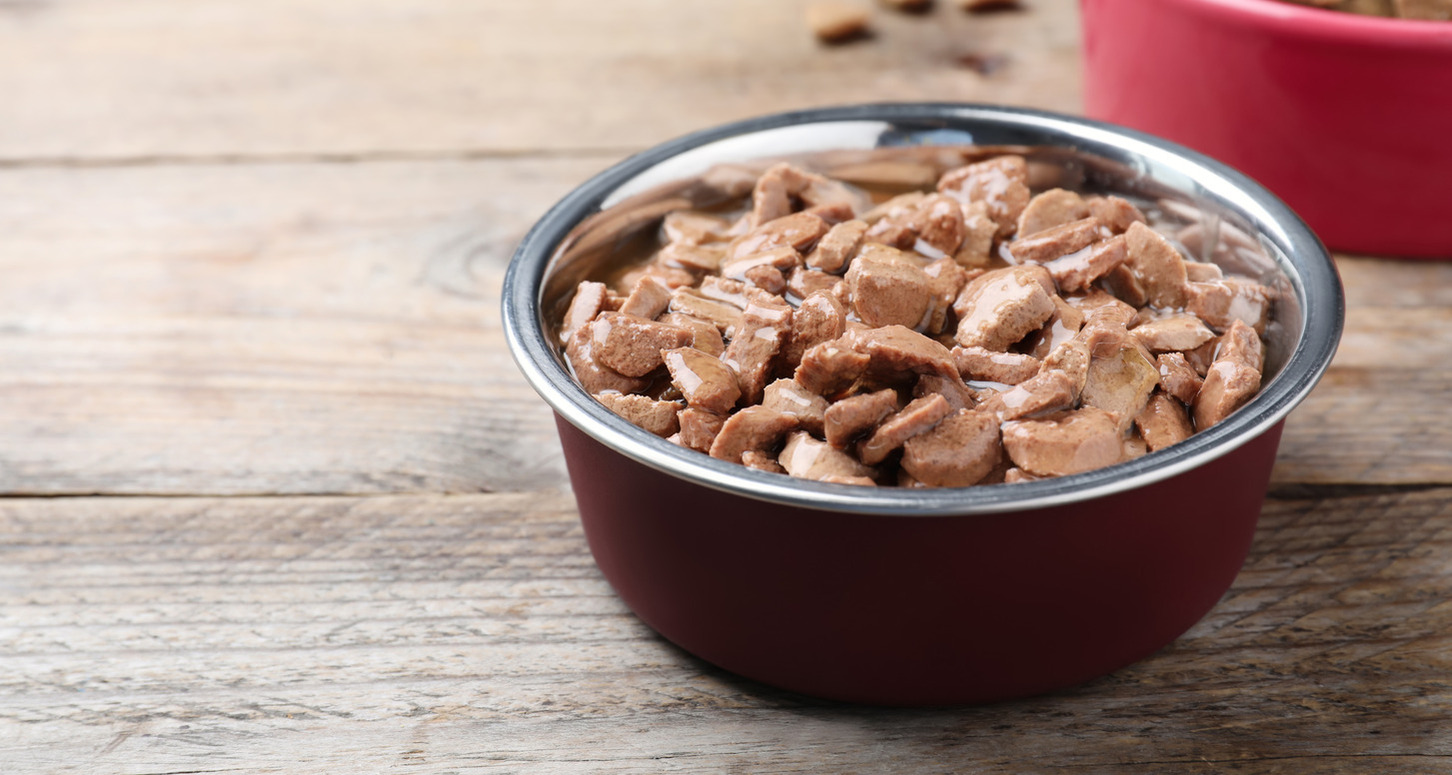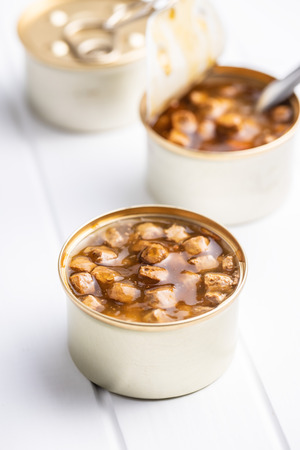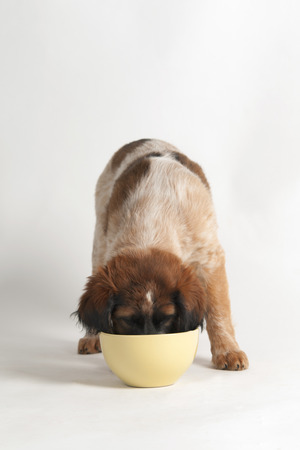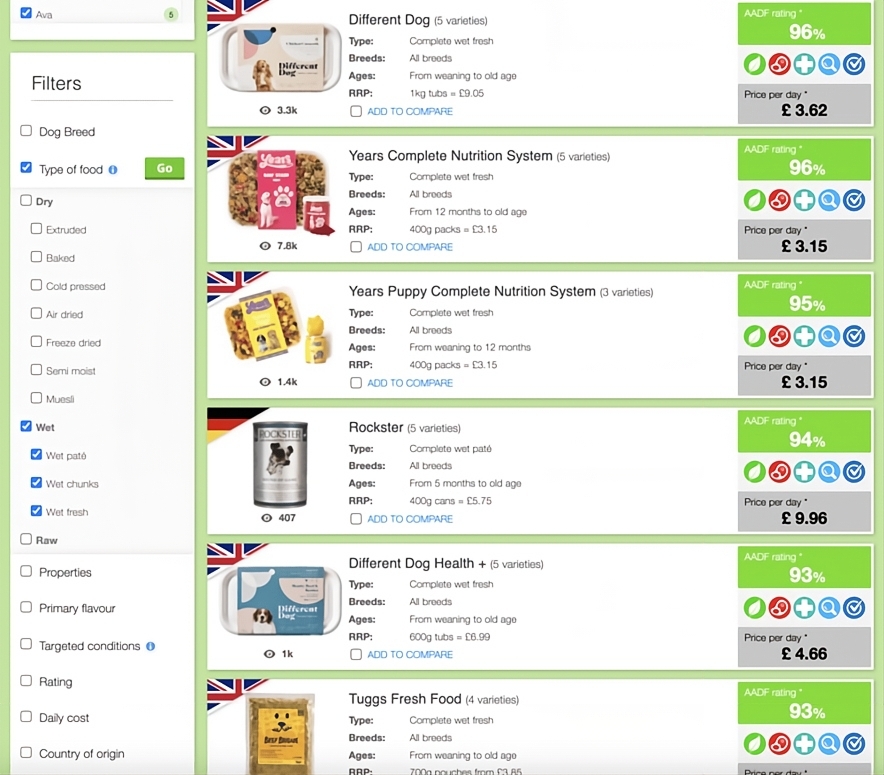Best Wet Dog Foods - Choosing the Right Option for Your Dog
December 12, 2024 | By David Jackson
Best Wet Dog Foods

Wet dog food has long been a favourite of dog owners, and for good reason.
With a soft texture, high moisture content, and delicious taste, it’s no wonder that so many pets go crazy for it. But with the vast number of options on the market today, choosing the best wet dog food for your pup can be tricky.
So, let's check out what makes a wet dog food great, and how to pick the perfect one for your four-legged fur buddy.
Table of Contents
What Is Wet Dog Food?
Wet dog food, commonly referred to as canned dog food, has a much higher moisture content than dry kibble, typically ranging from 70-85%.
It comes in cans, trays, or pouches, which are very handy for dog owners, and is loved by dogs for its rich aroma and soft texture.
Why Do Pet Owners Choose Wet Food?
There are a number of reasons why many pet owners choose a wet dog food over a raw or kibble, for instance:
Hydration and Kidney Health
The high-water content supports hydration, particularly for dogs that don’t drink enough on their own.
Gentle on Teeth
Its soft consistency is ideal for puppies, senior dogs, and those with dental issues.
Great for Picky Eaters
The rich taste and aroma make it a firm favourite for even the fussiest dogs.
Cost and Convenience
High-quality wet food may cost more, but investing in your dog’s nutrition can prevent costly vet bills in the future. Bulk-buying or subscribing to delivery services can help save money. Plus, as it comes in pouches, cans, or trays, wet dog food is great for saving freezer space!
What Makes Wet Food Different from Dry Food?
The main difference lies in its moisture content (that 70-85% is high!), but it also influences shelf life.
Although wet food must be consumed shortly after opening, offering less convenience in that sense over dry kibble's longer shelf life, it compensates by often containing fewer carbohydrates and more protein.
This makes it particularly suitable for dogs that could benefit from a higher-protein diet.
Key Ingredients to Look For
Just like your raw and dry kibbled foods, not all wet dog foods are created equal. Some may contain artificial additives and preservatives, others may be packed with fillers! So, to ensure you’re feeding your dog the best, it’s essential to understand what ingredients to look out for on the back of that tin or pouch...
High-Quality Protein
It’s a known fact that dogs need (and indeed enjoy eating) meat and the best wet dog foods will list meat as the primary ingredient. After all, this is where they get their protein from which is essential for supporting muscle development, immune health, and keeping their coat shiny and healthy.
Look for named proteins like chicken, beef, lamb, or salmon over products with vague labels like meat derivatives or meat by-products, as the clarity of what is actually in the food will be lacking.
Natural and Wholesome Additions
Vegetables like carrots, peas, and sweet potatoes provide essential vitamins and minerals for your dog and will help keep their health in tip-top shape.
Meanwhile, whole grains, such as brown rice or oats, will provide dietary fibre to support digestion.
There are, of course, foods that don’t contain grains too if your dog is sensitive to them, so always read the label to make sure no hidden grains are added.
Nutritional Balance
Here in the UK, you want to make sure the food is FEDIAF compliant. This guarantees that the product meets basic nutritional requirements for your dog’s specific life stage.
Ingredients to Avoid
Fillers and Artificial Additives
Low-quality wet dog foods may include fillers like corn, wheat, or soy, which provide minimal nutritional value.
Additionally, you want to avoid artificial preservatives (e.g., BHA, BHT) and synthetic colours or flavours, as they may pose health risks over time.
Excessive Sodium and Sugars
Some wet foods contain added salt or sugars to enhance flavour – which honestly baffles us as dogs don’t taste things the same way as humans.
Over time, these additives can lead to health issues such as obesity or high blood pressure.
Matching Wet Food to Your Dog’s Needs
Every dog has unique nutritional requirements based on their age, breed, activity level, and health status, so be sure to consider the following to make sure your chosen wet dog food meets their needs…
Puppies, Adults, and Seniors
 Puppies
Puppies need energy-rich, nutrient-dense food to support rapid growth. Wet food formulated for puppies contains higher levels of protein and calories which will meet their needs brilliantly.
Adult Dogs
For adults, maintaining energy levels and overall health is key. Look for wet food that provides balanced nutrition without excess calories.
Senior Dogs
Older dogs benefit from softer food due to potential dental issues – this is where wet dog food really comes into its own. Senior-specific wet foods often include joint-supporting nutrients like glucosamine and omega-3 fatty acids.
Breed-Specific Considerations
Large or Giant breeds may require additional joint support, while smaller breeds often prefer smaller portions with calorie-dense nutrition.
Once you’ve successfully established which food you need for your pup, remember to check out the All About Dog Food Directory to tailor your choice!
Health Benefits of Wet Dog Food
With the rise of raw, wet dog food sometimes gets a bit of a bad rap, but the truth is it can be a very healthy, balanced option for your pup. Some benefits of a wet food diet include:
Hydration
Wet food's high-water content supports hydration, a key factor in preventing urinary tract infections and promoting kidney health.
Dental Health
While wet food is gentle on sensitive teeth, it’s worth noting that it doesn’t clean teeth like dry kibble. However, combining wet food with natural chews like crunchy carrots can help maintain oral health.
Improved Appetite
Dogs recovering from illness or with decreased appetites often benefit from the rich flavours and enhanced palatability of wet food, making it a great choice for supporting their recovery.
Tips for Transitioning to Wet Dog Food
Switching to wet dog food requires a thoughtful approach to avoid upsetting your dog’s stomach:
- • Start Small: Mix a small amount of wet food with your dog’s current diet.
- • Gradually Increase: Over 7-10 days, increase the proportion of wet food while decreasing the old food.
- • Monitor Your Dog: Watch for signs of digestive upset, such as diarrhoea or changes in appetite. Slow the transition if necessary or stop and consult with your vet for advice.
It’s also important to consider your dog’s life stage and/or any health concerns. Active dogs will need higher protein options to suit their energy demands, while dogs with sensitivities may require foods with novel proteins and limited ingredients.
Choosing the Right Wet Dog Food
So, you’ve decided to give wet dog food a go - but with so many options out there, where do you even begin to narrow down your search to make sure your dog is getting everything it needs?
Fortunately for you, you’re one of our lovely supporters and we’ve made the whole process simple.
First, head over to our Dog Food Directory. From there you can select the type of food you want, ingredients you’d like to avoid like grains, and even set your daily budget target, plus many more filters to tailor your search just for your dog.
You can even compare foods if you’re stuck between one or another!

The best thing about using the All About Dog Food Directory is that our algorithm is always improving which means each food’s rating is constantly updating to provide you with the most accurate rating possible.
In Conclusion
Choosing the best wet dog food is about more than just satisfying your pup’s taste buds. It’s about providing the nutrition they need to live a long, healthy, happy life.
By prioritising high-quality ingredients, avoiding fillers, and tailoring your choice to your dog’s unique needs, you can ensure their meals are as beneficial as they are delicious.
Frequently Asked Questions
Is Wet Food Better Than Dry Food?
Each has its benefits. Wet food offers hydration and easier chewing, while dry food supports dental health. A combination of both can provide the best of both worlds.
How Much Wet Food Should I Feed My Dog?
Feeding guidelines vary based on your dog’s weight, age, and activity level. Always follow the manufacturer’s recommendations and consult your vet.
Can I Mix Wet and Dry Food?
Yes! Mixing the two can add variety and enhance your dog’s enjoyment of their meals.
Related Blog Posts Section
More From Our Blog
|